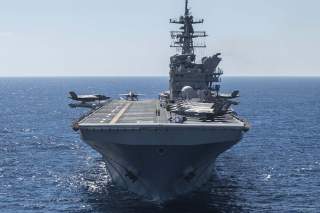How Iran Plans to Out Smart Trump: Enter the 'Grey Zone'
Tensions with Iran remain high.
While international attention has shifted to the Syrian-Turkish border this past week, Friday's attack on an Iranian oil tanker offshore of Saudi Arabia is a reminder that recent tensions with Iran remain high.
In its escalating confrontation with the United States and its allies, Iran has adopted Hall of Fame baseball player Willie Keeler's strategy to "hit 'em where they ain't." It clearly worked for Willie, and it is working equally well for Iran, which is astutely employing limited force while President Trump plainly avoids it.
The United States need not be so self-deterred for multiple reasons. Iran's military capabilities, though by no means minimal, are still dwarfed by those of the United States. Additionally, Iran is most readily compelled by credible threats or use of force, not economic pressure.
But most relevant, Iran's playbook offers an excellent model for achieving strategic objectives by operating in the "gray zone" between peace and open kinetic conflict. The gray zone often involves plausibly deniable use of force to minimize the consequences of escalation.
To restore deterrence while minimizing risks of escalation, Washington should contest Tehran in the gray zone using limited military actions that fly under the radar, but which Iran still recognizes as executed by the United States.
Since May, Iran has successfully harassed unguarded oil tankers and attacked Saudi Arabia's critical energy infrastructure, all without provoking a costly response, let alone outright conflict. Yet simultaneously, they send a clear message that the international community will face real costs for sanctioning Tehran's energy exports and other vital economic sectors.
Meanwhile, the Trump administration has done the opposite, speaking loudly about war while relying exclusively on sanctions. This is crippling U.S. credibility, practically inviting Iranian escalation by laying bare the disconnect between what the United States says and is willing to do.
When he has turned to the military, President Trump's actions so far have been visually demonstrative, but ultimately ineffectual, displays of conventional military power.
Amid heightened tensions with Iran this spring, and then again, in response to the attack on Saudi oil facilities, President Trump sent modest contingents of troops and air defenses to the Persian Gulf. Yet these defenses offer little capability for intercepting cruise missiles or drones like Iran used in the recent strike on Saudi Arabia or likely would use in the future.
Instead of relying exclusively on sanctions and overt demonstrations of military power, the United States should learn from Iran's successes and expand its gray zone operations. The administration's reported consideration of cyberattacks against Iran is a welcome first step, but more should be done.
Political warfare, including information operations, as well as sabotage, and other ambiguous military activities, are particularly attractive options to bolster pressure against Tehran. Indeed, well before the resumption of U.S. sanctions, internal social and political pressures were already mounting concerns for the Iranian regime. And as much as Tehran attempts to seal off its populace from foreign influence, information certainly does get through.
Iran's naval forces are particularly vulnerable in this regard. It operates both a regular navy and the Islamic Revolutionary Guard Corps (IRGC) navy, and the two engaged in friendly fire during the Iran-Iraq War in the 1980s on several occasions. This fissure is ripe for U.S. exploitation using cyberattacks to disrupt lines of communication between them.
The United States and its allies should force Iran to respond in multiple theatres, something it has previously resisted. The IRGC's elite expeditionary Quds Force is operating aggressively across the region in Iraq, Syria, Lebanon and Yemen, and more covertly in Bahrain, Qatar and the United Arab Emirates. Effectively countering these arteries will require expanding American and partner non-lethal interdiction efforts across the region.
These and other operations in the gray zone can reduce but not eliminate risks of escalation. American policymakers should focus on proportional, non-lethal responses to Iran's actions and avoid employing lethal force except in response to American deaths. Avoiding civilian casualties in Iran is particularly important in this context, as there are significant sympathies toward the West that will be critical to an eventual effort to bring the country back to the family of peaceful nations.
However, if Iran does not face military costs for its operations, it will continue to avoid diplomacy and launch increasingly dangerous and destabilizing attacks. The United States should develop a gray zone strategy not to provoke a war with Iran, but because it is the most productive way to avoid one while also rebuilding deterrence.
Lt Gen Thomas Trask, USAF (ret.), former Vice Commander of U.S. Special Operations Command, serves on the Hybrid Warfare Task Force at the Jewish Institute for National Security of America (JINSA), where Jonathan Ruhe and Ari Cicurel are Director of Foreign Policy and Policy Analyst, respectively.
This article originally appeared at Real Clear Defense.
Image: Reuters.

